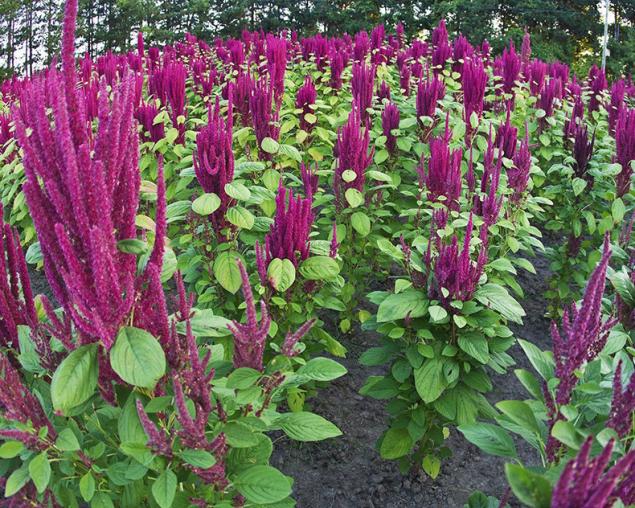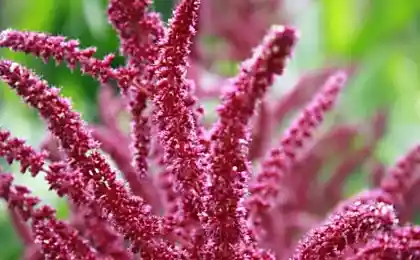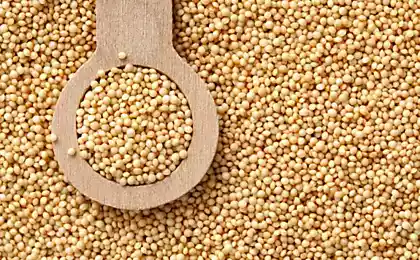1041
How to grow amaranth vegetable on your site
Internet is full of articles about the exclusive benefits of amaranth. Like, vegetable culture twenty-first century, on the content of protein is superior to milk, can feed the whole world, to prolong youth and people to help recovery of the body. And for all its many virtues in cultivation Amaranth unpretentious and undemanding.
One of the main advantages of the vegetable cultures is that in almost all suitable food plant parts: the leaves and stems, and (particularly valuable) seeds. It turns out, sin is not so advantageous to allocate a piece of land amaranth on their summer cottage. And we'll tell you everything you need to know and take into account for a great harvest of valuable amaranth.
The technology of growing vegetable amaranth
Amaranth - photophilous plant, heat-loving and responsive to irrigation. It grows in almost all types of soil, including sand, gravel, stone and salt marshes. Green ripening period 60-70 days, the seeds - 100-120 days
.
Amaranth is an excellent green manure and green manure. Therefore, to break off on food leaves, stems and tops should be, leaving the roots in the ground. Summer resident receives a vitamin salad, and soil microorganisms - the desired organic. And all is well!
Grow Amaranth in two ways: seedlings and nonseedlings. As a rule, the seedlings are planted grain amaranth varieties, to accelerate the growth and maturation period of seeds or ornamental varieties for early flowering. The cultivation of amaranth leaves vopolne for possible direct sowing of seeds into the soil.
The cultivation of amaranth sprouts through
On seedlings Amaranth seeds are planted in late March - early April. First, the seeds are sown in the public box and sprinkled with damp soil. Then cover with foil and send in a dark warm place. After 7-12 days, the seedlings appear, then rearrange the box on the windowsill.
With the advent of the first true leaf amaranth seedlings diving in pots. It is well tolerated transplant, so the problems should not be.
After the threat of frost has passed (at the end of May or beginning of June), the seedlings are planted to a permanent place.
The cultivation of amaranth direct sowing
Seeds are planted one in moist soil. They can be sown in late April-early May, when the soil has warmed up to + 6 ° C.
The distance between the bushes and rows may be any, depending on the immediate goal of cultivation. If you need powerful plant with a large number of panicles and seeds, the scheme 70h30 cm. If the preference is given the green herb, it is possible to thicken landing and take advantage of the scheme 15x15 cm.
Those who decided to plant amaranth larger area will be more convenient to mix the seed with sand, ash or sawdust at a ratio of 1:20 to sow in rows, and then thin out. Too bury seeds not worth enough to sprinkle them with soil at 1-2 cm, and a little roll on for better contact with the ground. In favorable conditions seedlings appear within 7-10 days.
Care and harvesting amaranth
Amaranth requires care only for the first month of growth. At this time his ground part grows so slowly that it's hard to believe if these bylinochki soon turn into powerful high bushes. Therefore it is necessary periodically to weed the flower bed, mulch the cut grass to prevent drying out, if you wish, you can feed the infusion of mullein and ash (or liquid fertilizer from grass).
Beginning with the second month of amaranth embarks on a rapid growth and add 5-7 centimeters per day. Now he is able to drown out any weeds, and all that it requires from the gardener, - regular watering
. On amaranth greens cut reaches the height of 20-25 centimeters. After cutting the tops of the lateral sinuses start to grow new shoots.
In early September, the seeds ripen. At this time, the panicle begin to grow brown, and the lower leaves dry up and fall off. Seeds ripen unevenly from amaranth and very quickly crumble, it would be preferable to cut the panicles in advance and dried in a dark place. Seeds ripen at the same time perfectly.
Amaranth varieties
Species and varieties of amaranth big set. Vegetable, grain, forage, decorative ... We were both gardeners are primarily interested in the universal varieties (which are grown as greens, and the "grain"), leaf and grain.
Valentina. A great variety of vegetable early with many shoots along the entire length of the stem. Leaves and stems are purple, purple flowers erect. Seeds translucent, light brown, with a red border. The height increases to 1, 7 meters. ripening period 45-60 days the leaves, seeds - 110-120 days
. Giant. Forage varieties that can be grown for grain. The leaves are dark green, red or yellow flowers, white seeds discoid. At the height grows 1, 6-1, 9 meters. The period from germination to seed ripening 115-127 days.
Fortress. Ripening vegetable varieties grown for the fresh greens. The leaves are green, juicy and tender, color brown with red spots. Seeds light yellow. The height reaches 1, 3-1, 4 meters. Growing season - 70-80 days
. White list (White Leaf). Vegetable dwarf varieties, grown on the greens. Cuts off when reaching a height of 18-20 centimeters. Leaves and stems are light green, very tender and tasty. This variety can be grown in the winter on the windowsill.
Kharkiv-1. Universal Class, one of the best for growing grain. The leaves are green, yellow inflorescences erect, light seeds. The height reaches 1, 7-1, 9 meters. vegetation period - 90-110 days
. Memory Covas. Universal middle-grade. The leaves are dark green, very juicy and tender. Inflorescences erect red with a brown tint. The plant height of 0, 9-1, 1 meter.
Voronezh. Ripening grain variety. The leaves are green, long erect panicles of yellow-green hue, light seeds. The average height of the plants 0, 8-1, 2 meters. grain ripening - 90-100 days
. Helios. Grain early maturing variety. The leaves are light yellow with orange streaks, erect panicles orange, white grain. It may grow to 1, 5-1, 7 meters high. The period of ripening seeds - 105 days
. Kizlyarets. It is believed forage varieties that can be grown for grain. The leaves are large, light green. Inflorescence - panicle direct yellow-green when ripe is red. Seeds rounded, light yellow. Plants reach 1, 2-1, 6-meter height. grain ripening - 80-120 days
. Remember that vegetable and cereal varieties of amaranth seed color should be light. If the seeds are dark, this decorative amaranth, which is grown for its beautiful bright panicles. Grains of these plants for food use is not recommended, but the leaves can be added to salads in the summer anyway.
One of the main advantages of the vegetable cultures is that in almost all suitable food plant parts: the leaves and stems, and (particularly valuable) seeds. It turns out, sin is not so advantageous to allocate a piece of land amaranth on their summer cottage. And we'll tell you everything you need to know and take into account for a great harvest of valuable amaranth.
The technology of growing vegetable amaranth
Amaranth - photophilous plant, heat-loving and responsive to irrigation. It grows in almost all types of soil, including sand, gravel, stone and salt marshes. Green ripening period 60-70 days, the seeds - 100-120 days
.

Amaranth is an excellent green manure and green manure. Therefore, to break off on food leaves, stems and tops should be, leaving the roots in the ground. Summer resident receives a vitamin salad, and soil microorganisms - the desired organic. And all is well!
Grow Amaranth in two ways: seedlings and nonseedlings. As a rule, the seedlings are planted grain amaranth varieties, to accelerate the growth and maturation period of seeds or ornamental varieties for early flowering. The cultivation of amaranth leaves vopolne for possible direct sowing of seeds into the soil.
The cultivation of amaranth sprouts through
On seedlings Amaranth seeds are planted in late March - early April. First, the seeds are sown in the public box and sprinkled with damp soil. Then cover with foil and send in a dark warm place. After 7-12 days, the seedlings appear, then rearrange the box on the windowsill.
With the advent of the first true leaf amaranth seedlings diving in pots. It is well tolerated transplant, so the problems should not be.
After the threat of frost has passed (at the end of May or beginning of June), the seedlings are planted to a permanent place.
The cultivation of amaranth direct sowing
Seeds are planted one in moist soil. They can be sown in late April-early May, when the soil has warmed up to + 6 ° C.
The distance between the bushes and rows may be any, depending on the immediate goal of cultivation. If you need powerful plant with a large number of panicles and seeds, the scheme 70h30 cm. If the preference is given the green herb, it is possible to thicken landing and take advantage of the scheme 15x15 cm.
Those who decided to plant amaranth larger area will be more convenient to mix the seed with sand, ash or sawdust at a ratio of 1:20 to sow in rows, and then thin out. Too bury seeds not worth enough to sprinkle them with soil at 1-2 cm, and a little roll on for better contact with the ground. In favorable conditions seedlings appear within 7-10 days.
Care and harvesting amaranth
Amaranth requires care only for the first month of growth. At this time his ground part grows so slowly that it's hard to believe if these bylinochki soon turn into powerful high bushes. Therefore it is necessary periodically to weed the flower bed, mulch the cut grass to prevent drying out, if you wish, you can feed the infusion of mullein and ash (or liquid fertilizer from grass).
Beginning with the second month of amaranth embarks on a rapid growth and add 5-7 centimeters per day. Now he is able to drown out any weeds, and all that it requires from the gardener, - regular watering
. On amaranth greens cut reaches the height of 20-25 centimeters. After cutting the tops of the lateral sinuses start to grow new shoots.
In early September, the seeds ripen. At this time, the panicle begin to grow brown, and the lower leaves dry up and fall off. Seeds ripen unevenly from amaranth and very quickly crumble, it would be preferable to cut the panicles in advance and dried in a dark place. Seeds ripen at the same time perfectly.
Amaranth varieties
Species and varieties of amaranth big set. Vegetable, grain, forage, decorative ... We were both gardeners are primarily interested in the universal varieties (which are grown as greens, and the "grain"), leaf and grain.
Valentina. A great variety of vegetable early with many shoots along the entire length of the stem. Leaves and stems are purple, purple flowers erect. Seeds translucent, light brown, with a red border. The height increases to 1, 7 meters. ripening period 45-60 days the leaves, seeds - 110-120 days
. Giant. Forage varieties that can be grown for grain. The leaves are dark green, red or yellow flowers, white seeds discoid. At the height grows 1, 6-1, 9 meters. The period from germination to seed ripening 115-127 days.
Fortress. Ripening vegetable varieties grown for the fresh greens. The leaves are green, juicy and tender, color brown with red spots. Seeds light yellow. The height reaches 1, 3-1, 4 meters. Growing season - 70-80 days
. White list (White Leaf). Vegetable dwarf varieties, grown on the greens. Cuts off when reaching a height of 18-20 centimeters. Leaves and stems are light green, very tender and tasty. This variety can be grown in the winter on the windowsill.
Kharkiv-1. Universal Class, one of the best for growing grain. The leaves are green, yellow inflorescences erect, light seeds. The height reaches 1, 7-1, 9 meters. vegetation period - 90-110 days
. Memory Covas. Universal middle-grade. The leaves are dark green, very juicy and tender. Inflorescences erect red with a brown tint. The plant height of 0, 9-1, 1 meter.
Voronezh. Ripening grain variety. The leaves are green, long erect panicles of yellow-green hue, light seeds. The average height of the plants 0, 8-1, 2 meters. grain ripening - 90-100 days
. Helios. Grain early maturing variety. The leaves are light yellow with orange streaks, erect panicles orange, white grain. It may grow to 1, 5-1, 7 meters high. The period of ripening seeds - 105 days
. Kizlyarets. It is believed forage varieties that can be grown for grain. The leaves are large, light green. Inflorescence - panicle direct yellow-green when ripe is red. Seeds rounded, light yellow. Plants reach 1, 2-1, 6-meter height. grain ripening - 80-120 days
. Remember that vegetable and cereal varieties of amaranth seed color should be light. If the seeds are dark, this decorative amaranth, which is grown for its beautiful bright panicles. Grains of these plants for food use is not recommended, but the leaves can be added to salads in the summer anyway.























